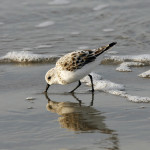• • •
Sanderlings rarely sit still, scooting rapidly between advancing and retreating water on the beach in a start-and-stop motion, their small black legs moving so fast that they’re almost a blur. They are larger than the other “peeps” but still a challenge to distinguish, particularly when juvenile.
• Length: 8 inches
• Wingspan: 17 inches
• Season: Winter
More about Sanderlings.
Where they are, and when.
They forage for stranded invertebrates or poke the wet sand in the retreating water on the shoreline. Their diet includes crabs and other small crustaceans, marine worms, mollusks and horseshoe crab eggs. When no prey is available, they’ll turn vegetarian, pecking at algae and moss.
They are winter visitors to the Texas Gulf Coast – and just about every other beach in the north and south hemispheres, breeding in summer in the high Arctic tundra. They gather in small, loose flocks on the beach or mudflats with other shorebirds. When threatened by falcon or other predator, they take to the air in a tight ball that zig-zags over the ocean.






You must be logged in to post a comment.